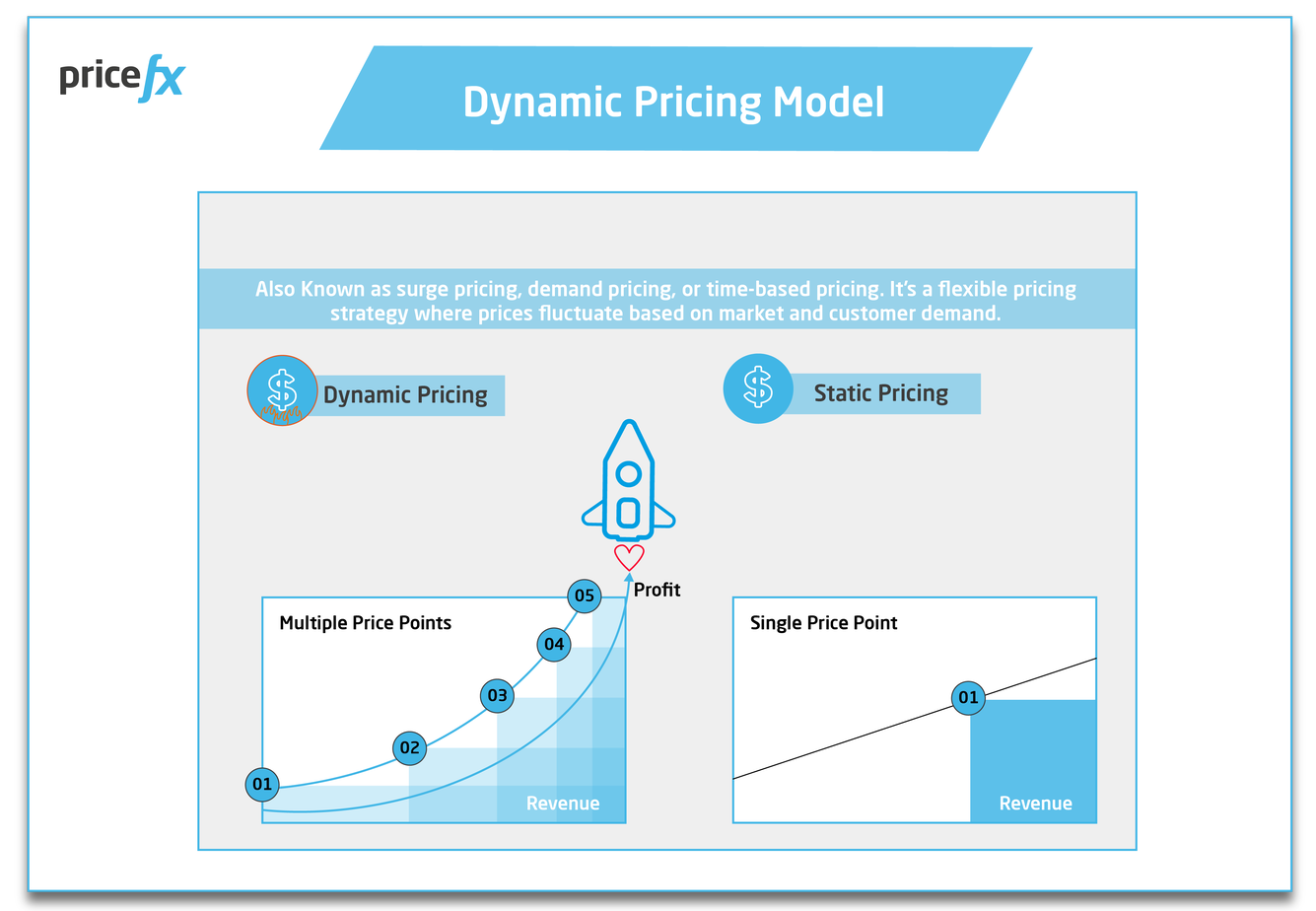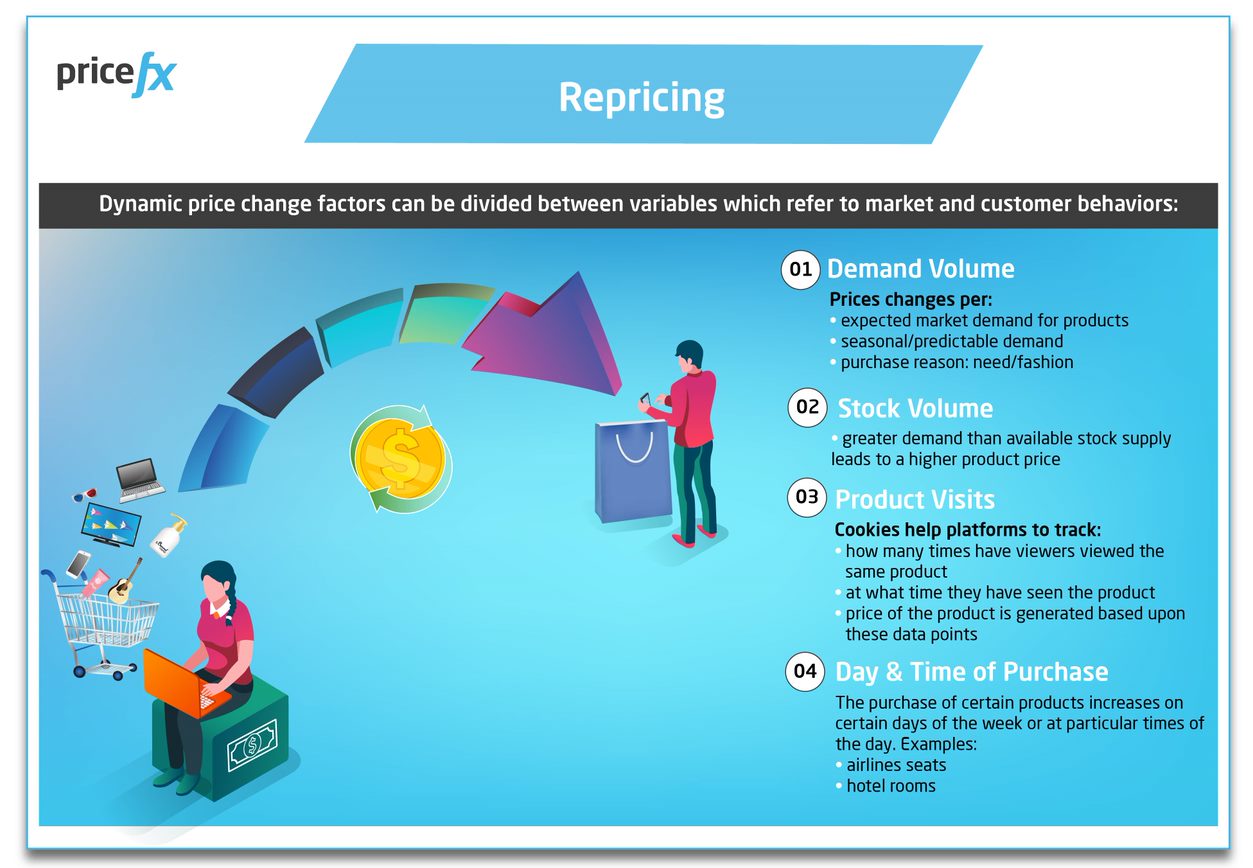Price Optimization vs Dynamic Pricing: In B2B & B2C
August 31st, 2023 | 11 min. read
Pricing is a critical component of any business strategy, but deciding on the right approach can be challenging. Two popular techniques for pricing in today’s marketplace are price optimization and dynamic pricing. Price optimization involves using data analysis and algorithms to set prices that will achieve defined (e.g., maximizing profits, while dynamic pricing involves adjusting prices at a high frequency based on internal and external factors that are impacting pricing strategies. Both approaches can be effective for both B2B and B2C businesses but choosing the right one depends on a variety of factors, including the type of business, the products or services being sold, and your target objectives and consumer audience. In this article, we will explore the differences between price optimization and dynamic pricing, examine the benefits and drawbacks of each approach, and compare how one or the other, or even using both techniques simultaneously can be effective for B2B and B2C businesses.
At Pricefx over the last decade and more we have implemented our pricing software technology to assist hundreds of clients across the globe to build profitability and streamline efficiencies in their organizations. Part of that process has been to work together with those companies to develop a customized pricing strategy from a selection of competing techniques and approaches that matches their unique set of overall business objectives.
Let’s get started by firstly defining exactly what both price optimization and dynamic pricing entail, before analyzing their respective or joint uses for different types of business.
What is Price Optimization?
Price optimization is a pricing technique that aims to find the ideal price for your company’s product or service that maximizes profits while satisfying customer demand. The process involves analyzing data on customer behavior, market trends, and pricing history to determine the most effective pricing strategy.
The goal of price optimization is to find the right balance between pricing a product or service to achieve your company objective. And in most cases that will be profit maximization and increasing margins.
Price optimization can be a complex process, but it is a crucial component of any successful pricing strategy for businesses that want to stay competitive and maximize their profits.
One of the most critical aspects of price optimization is understanding customer behavior. Businesses need to know how their customers respond to changes in prices, how price sensitivity varies across different customer segments, and how demand changes over time.
Price optimization also requires a thorough analysis of market trends and competition. Businesses need to understand how their competitors are pricing comparable products or services and how changes in the market can affect demand.
There are various approaches to price optimization, including rule-based and algorithmic methods. Rule-based methods involve setting pricing guidelines based on specific criteria, such as cost-plus pricing or target profit margins. Algorithmic methods use artificial intelligence and machine learning algorithms to analyze data and predict optimal prices.
What You Can Do with Price Optimization – An Example
Imagine you own a shoe company, and you sell three types of shoes: summer shoes, waterproof winter shoes and all-season basketball shoes for the European, Australian, NZ, and North American markets where the NBA is most popular.
Having determined your pricing strategy for each of your three products, you have decided that you want to:
- Increase Sales volume by 25% on your basketball shoes to lower production costs (as these are your products with a niche market globally numbers)
- Have a standard 30% profit margin on your summer shoes
- Have a standard 40% profit margin on your winter shoes and;
- You want to simultaneously apply all these business outcomes and apply them as business rules in every market you sell in except for Spain, Greece, Turkey, Australia, New Zealand, and Brazil, where you are using periodic discounting on your basketball shoes to break into what are new and emerging markets for your company and to raise your brand awareness in those areas.
With Price Optimization Software, we can combine business constraints, business targets and rules to be taken into account for optimization in calculating your global price lists.
Price optimization is typically more suitable (but not always) for those types of B2B businesses that sell products or services with a relatively stable demand and a long sales cycle. For example, a company that sells industrial machinery may have a limited number of customers, but each customer makes significant purchases over a more extended period. In this case, price optimization can help the business find the right price for each customer, maximizing profits over time.
But B2C companies can benefit from price optimization also. For example, a clothing retailer may use price optimization to determine the best price for a popular item based on factors like its production cost, inventory levels, and the prices charged by its competitors, resulting in increased sales and profits. Or a hotel may use price optimization to determine the optimal room rate based on occupancy rates, time of year, and competitor prices. By offering competitive rates, the hotel can attract more customers while maximizing revenue and profit.
By considering customer data and analytics, businesses can make informed decisions about pricing and remain competitive in the market. What’s more, with the help of predictive analytics, businesses can better understand their customers and their needs, allowing them to make better pricing decisions and stay ahead of their competitors.
What is Dynamic Pricing?
Dynamic pricing is a pricing strategy that involves adjusting prices in real-time based on changes in demand, supply, or other external factors. The goal is to maximize profits by charging the highest price possible when demand is high and reducing prices when demand is low.

One of the most common examples of dynamic pricing is airline pricing. Airlines adjust their prices based on factors such as demand, time of day, day of the week, and season. For example, airlines may charge higher prices for tickets during peak travel times or holidays.
Dynamic pricing is also used in the hotel industry, where prices may fluctuate based on occupancy levels or events in the local area. Online retailers, such as Amazon, also use dynamic pricing to adjust prices based on customer behavior and market trends.
Amazon is by far the world’s largest e-commerce business with its 2020 sales in the United States alone amounting to approximately $386 billion. And Amazon is quite literally, dynamic pricing strategy in action.
Amazon’s pricing strategy is built upon offering the most competitive prices to shoppers. Prices on Amazon’s site are not constant and can change multiple times every day. That is why one form of dynamic pricing is referred to as ‘repricing.’
The low prices on offer at Amazon ensure brand loyalty and retention and make it profitable for sellers to sell their products while building a substantial customer base through significant visibility of their products on the Amazon platform.
Understanding the Amazon model then, we can see that dynamic pricing is particularly effective for B2C businesses that sell products with a high degree of variability in demand. For example, a clothing retailer may use dynamic pricing to adjust prices based on seasonal trends, inventory levels, and customer demand.
However, dynamic pricing is also a strategy that can be used as an effective tool in B2B relationships too. For example, a manufacturer that depends on raw materials (such as lumber, or oil that have been highly price volatile over the past couple of years) may use dynamic pricing to counteract wildly fluctuating costs in their production. This approach can help those types of companies cover significant price fluctuation to avoid margin leakage by passing on cost increases to their customers. If the price increase is well-explained through open and honest communication, those types of price increases are generally well understood by customers.
Price Optimization vs Dynamic Pricing – Surprise – Both Could Be Best for Your Business!
Both price optimization and dynamic pricing have their strengths and weaknesses, and the effectiveness of each strategy depends on the type of business and the products or services being sold.
Price optimization is ideal for B2B businesses (but can be used in a B2C environment too) that sells products or services with a more stable demand and a longer sales cycle. In these cases, price optimization can help businesses find the ideal price for each customer, maximizing profits over time.
On the other hand, dynamic pricing (whilst also used for B2B as mentioned above) is usually more effective for B2C businesses that sell products with a higher degree of variability in demand.
Dynamic pricing allows businesses of all types to adjust prices in real-time based on changes in customer behavior, inventory levels, or other external factors.
- Price optimization is ideal for B2B businesses that sell products or services with a more stable demand and a longer sales cycle. In these cases, price optimization can help businesses find the ideal price for each customer, maximizing profits over time.
- On the other hand, dynamic pricing (whilst used for B2B as mentioned above) is more effective for B2C businesses that sell products with a higher degree of variability in demand. Dynamic pricing allows businesses to adjust prices in real-time based on changes in customer behavior, inventory levels, or other external factors.
- However, there is a growing trend developing that price optimization and dynamic pricing are beginning to work hand-in-hand more frequently as markets and customers begin to become more complex.
You should also be aware there are also some potential downsides to dynamic pricing. For example, if customers perceive that prices are changing too frequently or unpredictably, they may become less loyal to the brand. Customers may also feel that they are being unfairly charged higher prices during peak demand periods.
Another potential drawback of dynamic pricing is the complexity of the pricing strategy. Dynamic pricing requires businesses to have access to enormous amounts of data and the ability to analyze that data quickly to make pricing decisions in real-time. Smaller businesses with limited resources may struggle to implement dynamic pricing effectively.
Price optimization, on the other hand, may be more straightforward and easier to implement, particularly with the use of a pricing software solution. However, price optimization may not capture the nuances of B2C customer behavior as effectively as dynamic pricing, which could result in missed opportunities for maximizing profits.
Another difference between price optimization and dynamic pricing is the level of customer involvement in the pricing process:
- Price optimization tends to be more internal facing, with businesses analyzing data to determine the most effective pricing strategy.
- Dynamic pricing, on the other hand, is more customer-facing, with businesses adjusting prices based on customer behavior and external factors. This approach can help businesses build closer relationships with their customers by offering personalized pricing based on their individual needs and preferences.
- Increasingly, businesses require both pricing options to work together to coordinate simultaneously with internal pricing teams, suppliers and customers.
Consequently, choosing between a price optimization technique and a dynamic pricing strategy will largely depend on the unique characteristics and goals of your organization’s business model.
While both approaches aim to maximize revenue and profit, the decision on which one to use comes down to how your business operates and what strategies align with your overarching goals.
And who knows? Your business could be one of those that needs both pricing techniques.
Choosing the Right Pricing Technique or Strategy for You
The decision of whether to use price optimization or dynamic pricing for your organization depends on numerous factors, such as the type of business, the products or services being sold, and the target audience.
B2B businesses that sell products or services with stable demand and long sales cycles may find that price optimization is the most effective strategy. Price optimization can help these businesses find the ideal price for each customer, maximizing profits over time.
B2C businesses that sell products with a higher degree of variability in demand may find that dynamic pricing is more effective. Dynamic pricing allows businesses to adjust prices in real-time based on changes in customer behavior, inventory levels, or other external factors.
But given the evolution of the business world and pricing in particular, your company might benefit from both.
Ultimately, businesses should choose the pricing strategy that aligns with their goals and values and meets the needs of their customers. Furthermore, whichever method you adopt in your business, pricing software like the award-winning Pricefx solution will assist you in making the most possible from your chosen method.
Click on the following link if you would like to learn more about Optian, Pricefx’s price optimization software solution.
On the other hand, if you would like to learn more about a total pricing software solution can help you with either dynamic pricing, price optimization or both, click on the link below to talk to one of our pricing experts now:
Happy Pricing!




